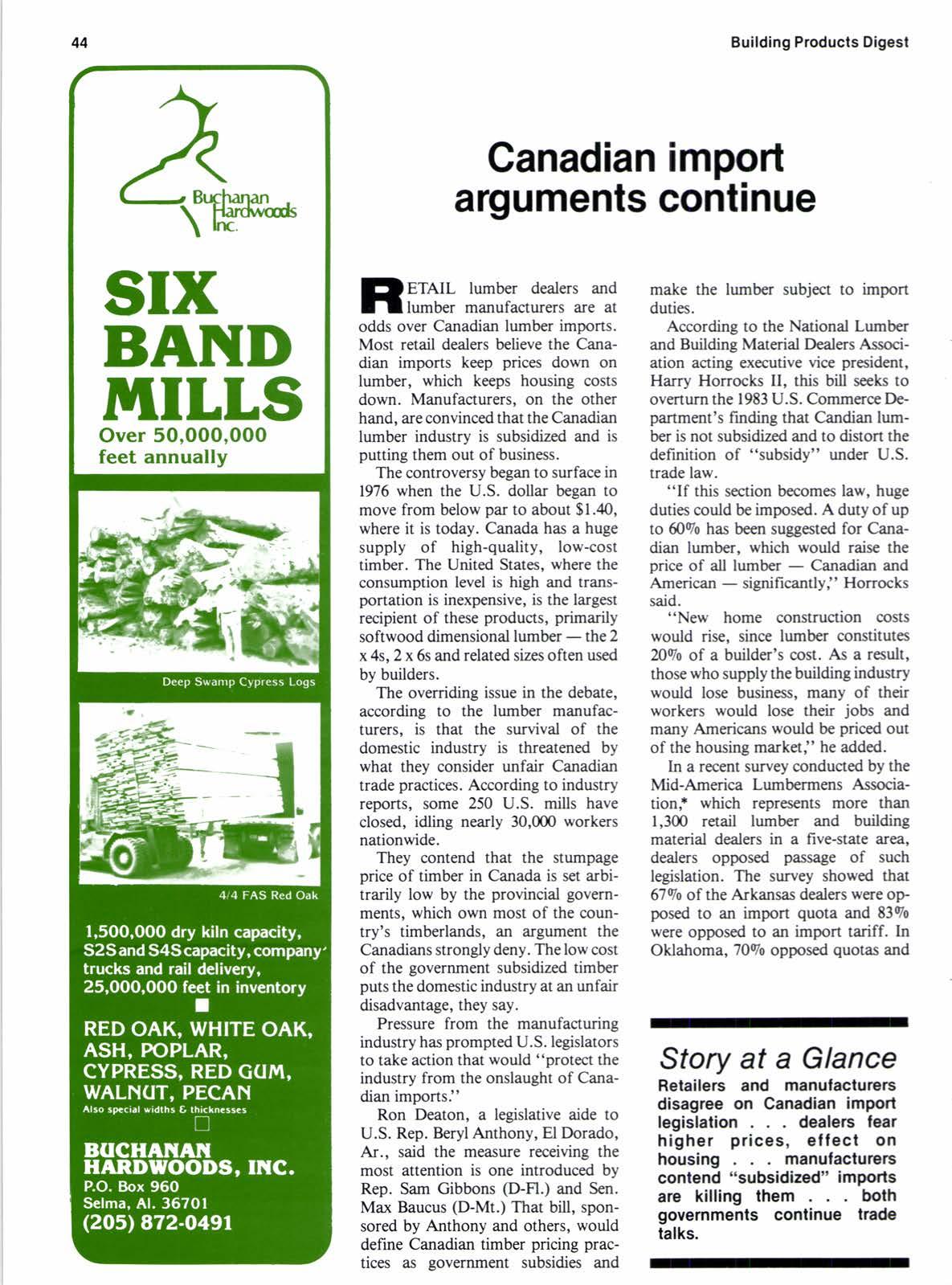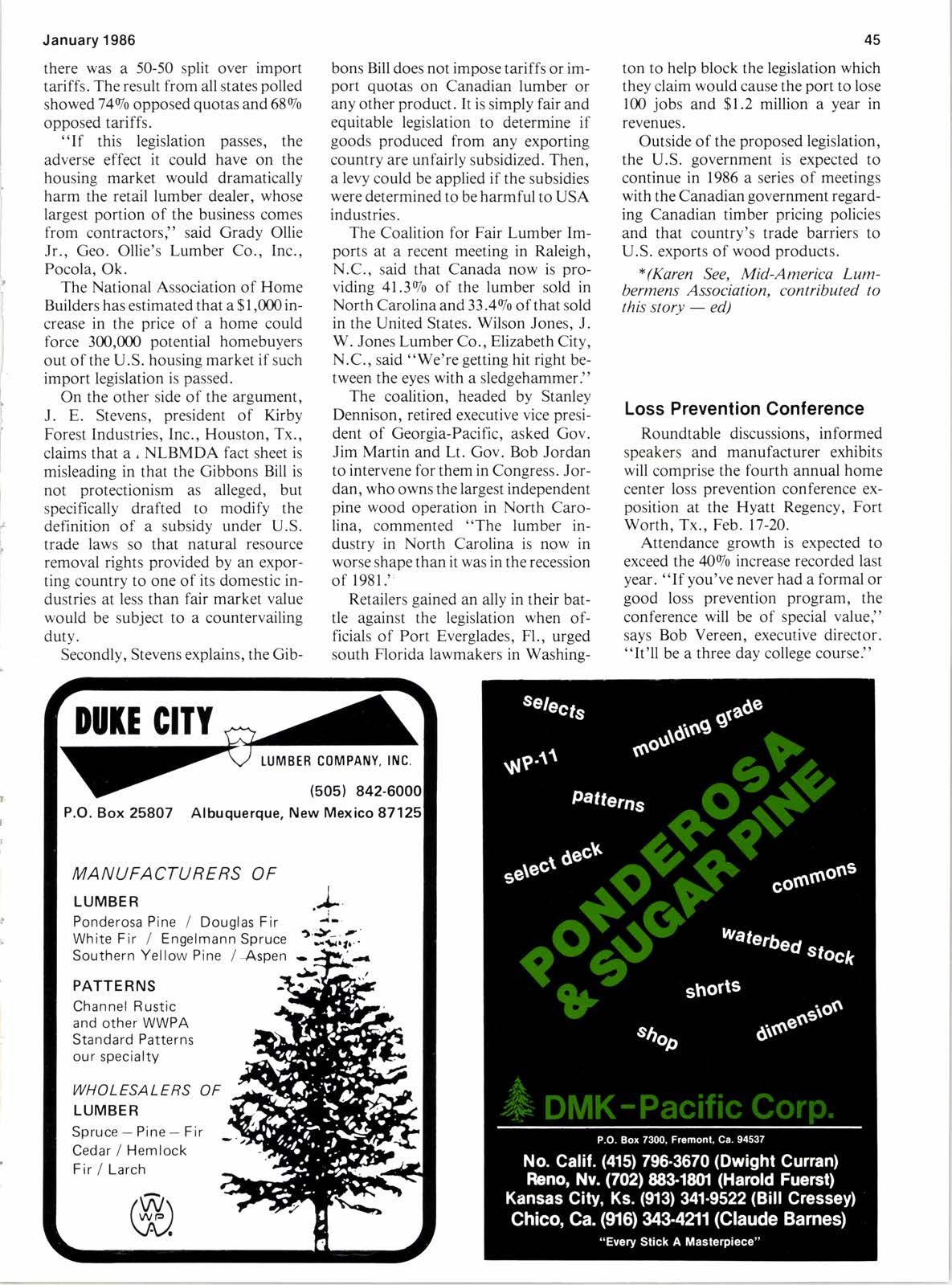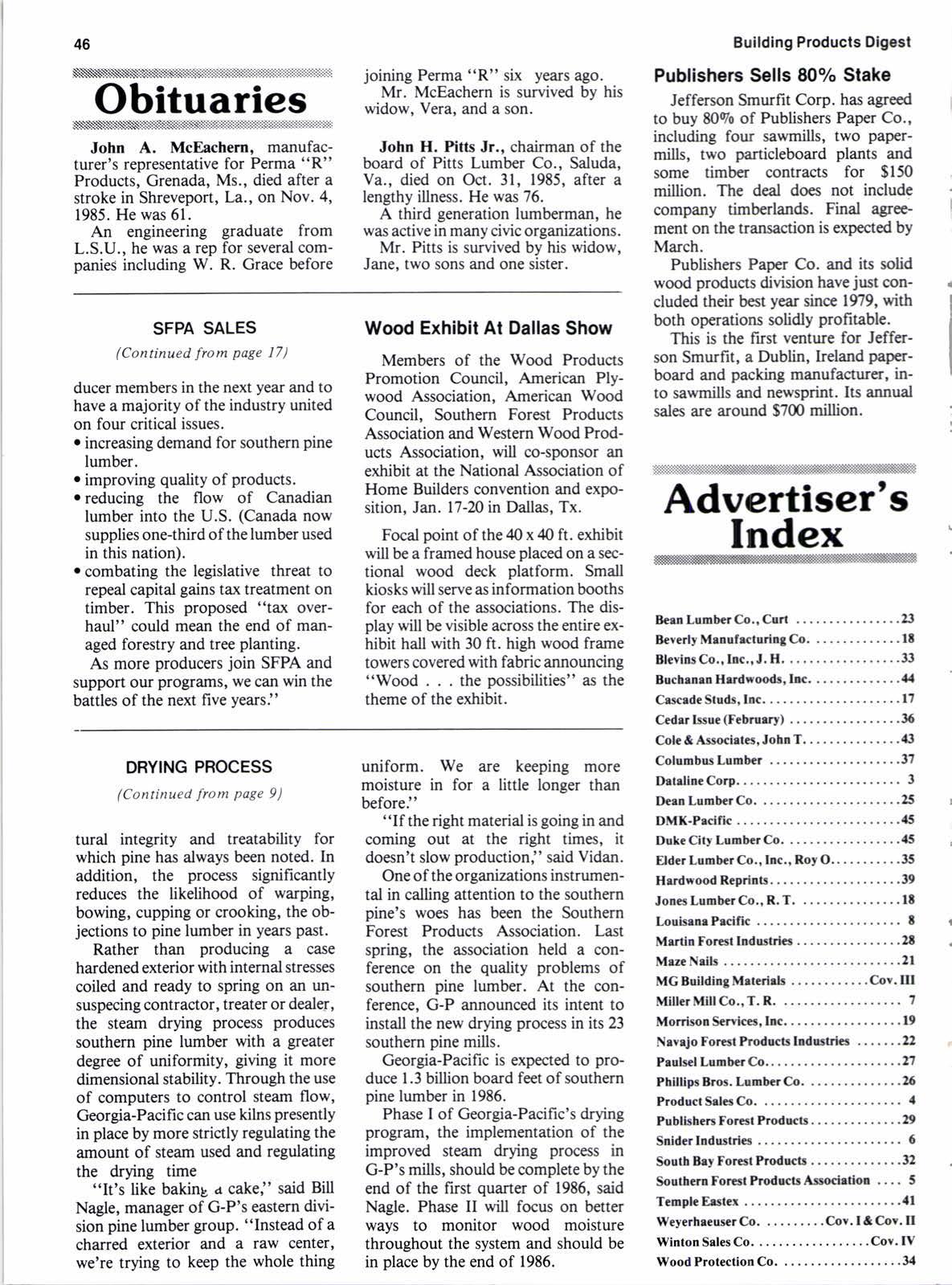
7 minute read
Canadian import arguments continue
Elnreu- lumber dealers and Illumber manufacturers are at odds over Canadian lumber imports. Most retail dealers believe the Canadian imports keep prices down on lumber, which keeps housing costs down. Manufacturers, on the other hand, are convinced that the Canadian lumber industry is subsidized and is putting them out of business.
The controversy began to surface in 196 when the U.S. dollar began to move from below par to about $1.40, where it is today. Canada has a huge supply of high-quality, low-cost timber. The United States, where the consumption level is high and transportation is inexpensive, is the largest recipient of these products, primarily softwood dimensional lumberthe 2 x 4s, 2 x 6s and related sizes often used by builders.
The overriding issue in the debate, according to the lumber manufacturers, is that the survival of the domestic industry is threatened by what they consider unfair Canadian trade practices. According to industry reports, some 250 U.S. mills have closed, idling nearly 30,(m workers nationwide.
They contend that the stumpage price of timber in Canada is set arbitrarily low by the provincial governments, which own most of the country's timberlands, an argument the Canadians strongly deny. The low cost of the government subsidized timber puts the domestic industry at an unfair disadvantage, they say.
Pressure from the manufacturing industry has prompted U.S. l€islators to take action that would "protect the industry from the onslaught of Canadian imports."
Ron Deaton, a legislative aide to U.S. Rep. Beryl Anthony, El Dorado, Ar., said the measure receiving the most attention is one introduced by Rep. Sam Gibbons (DFl.) and Sen. Max Baucus (D-Mt.) That bill, sponsored by Anthony and others, would define Canadian timber pricing practices as government subsidies and make the lumber subject to import duties. ln a recent survey conducted by the Mid-America Lumbermens Association,t which represents more than 1,3(X) retail lumber and building material dealers in a five'state area, dealers opposed passage of such legislation. The survey showed that 6790 of the Arkansas dealers were op posed to an import quota and 8390 were opposed to an import tariff. In Oklahoma, 7090 opposed quotas and
According to the National Lumber and Building Material Dealers Association acting excutive vice president, Harry Horrocks ll, this bill seeks to overturn the 1983 U.S. C-ommerce De partment's finding that Candian lumber is not subsidized and to distort the dehnition of "subsidy" under U.S. trade law.
"If this section becomes law, huge duties could be imposed. A duty of up to 6090 has been suggested for Canadian lumber, which would raise the price of all lumberC-anadian and AmericansigniFrcantly," Horrocks said.
"New home aonsruction @sts would rise, since lumber constitutes 200/o of a builder's cost. As a result, those who supply the building industry would lose business, many of their workers would lose their jobs and many Americans would be priced out of the housing market," he added.
Story at a Glance
there was a 50-50 split over import tariffs. The result from all states polled showed 7490 opposed quotas and 6890 opposed tariffs.
"If this legislation passes, the adverse effect it could have on the housing market would dramatically harm the retail lumber dealer. whose largest portion of the business comes from contractors," said Grady Ollie Jr., Geo. Ollie's Lumber Co., Inc., Pocola, Ok.
The National Association of Home Builders has estimated that a $ I ,000 increase in the price of a home could force 300,000 potential homebuyers out of the U.S. housing market if such import legislation is passed.
On the other side of the argument, J. E. Stevens, president of Kirby Forest Industries, Inc., Houston, Tx., claims that a. NLBMDA fact sheet is misleading in that the Gibbons Bill is not protectionism as alleged, but specifically drafted to modify the definition of a subsidy under U.S. trade laws so that natural resource removal rights provided by an exporting country to one of its domestic industries at less than fair market value would be subject to a countervailing duty.

Secondly, Stevens explains, the Gib- bons Bill does not impose tariffs or import quotas on Canadian lumber or any other product. It is simply fair and equitable legislation to determine if goods produced from any exporting country are unfairly subsidized. Then, a levy could be applied if the subsidies were determined to be harmful to USA industries.
The Coalition for Fair Lumber Imports at a recent meeting in Raleigh, N.C., said that Canada now is providing 41.390 of the lumber sold in North Carolina and 33.4Vo of that sold in the United States. Wilson Jones, J. W. Jones Lumber Co., Elizabeth City, N.C., said "We're getting hit right between the eyes with a sledgehammer."
The coalition, headed by Stanley Dennison, retired executive vice president of Georgia-Pacific, asked Gov. Jim Martin and Lt. Gov. Bob Jordan to intervene for them in Congress. Jordan, who owns the Iargest independent pine wood operation in North Carolina. commented "The lumber industry in North Carolina is now in worse shape than it was in the recession of 1981.''
Retailers gained an ally in their battle against the legislation when officials of Port Everglades, Fl., urged south Florida lawmakers in Washine- ton ro help block the legislation which they claim would cause the port to lose 100 jobs and $1.2 million a year in revenues.
Outside of the proposed legislation, the U.S. government is expected to continue in 1986 a series of meetings with the Canadian government regarding Canadian timber pricing policies and that country's trade barriers to U.S. exports of wood products.
*(Ksren See, Mid-Americq Lumbermens Association, contributed to this storyed)
Loss Prevention Conference
Roundtable discussions. informed speakers and manufacturer exhibits will comprise the fourth annual home center loss prevention conference exposition at the Hyatt Regency, Fort Worth, Tx., Feb. l7-20.
Attendance growth is expected to exceed the 4AVo increase recorded last year. "If you've never had a formal or good loss prevention program, the conference will be of special value," says Bob Vereen, executive director. "It'll be a three day college course."
John A. McEachern, manufacturer's representative for Perma "R" Products, Grenada, Ms., died after a stroke in Shreveport, La., on Nov. 4, 1985. He was 61.

An engineering graduate from L.S.U., he was a rep for several companies including W. R. Grace before
Sfpa Sales
(Continued from page 17) ducer members in the next year and to have a majority of the industry united on four critical issues. o increasing demand for southern pine lumber. o improving quality of products. o reducing the flow of Canadian lumber into the U.S. (Canada now supplies one-third of the lumber used in this nation). r combating the legislative threat to repeal capital gains tax treatment on timber. This proposed "tax overhaul" could mean the end of managed forestry and tree planting. As more producers join SFPA and support our programs, we can win the battles of the next five years." joining Perma "R" six years ago.
Mr. McEachern is survived by his widow, Vera, and a son.
John H. Pitts Jr., chairman of the board of Pitts Lumber Co., Saluda, Va., died on Oct. 31, 1985, after a lenghy illness. He was 76.
A third generation lumberman, he was active in many civic organizations.
Mr. Pitts is survived by his widow, Jane, two sons and one sister.
Wood Exhibit At Dallas Show
Members of the Wood Products Promotion Council, American Plywood Association, American Wood Council, Southern Forest Products Association and Western Wood Products Association, will co-sponsor an exhibit at the National Association of Home Builders convention and exposition, Jan. l7-2Our Dallas, Tx.
Focal point ofthe 40 x 4O ft. exhibit will be a framed house placed on a sectional wood deck platform. Small kiosks will serve as information booths for each of the associations. The display will be visible across the entire exhibit hall with 30 ft. high wood frame towers covered with fabric announcing "Wood the possibilities" as the theme of the exhibit.
Publishers Sells 80% Stake
Jefferson Smurfit Corp. has agreed to buy 8O9o of Publishers Paper Co., including four sawmills, two papermills, two particleboard plans and some timb€r contracts for $150 million. The deal does not include company timberlands. Final agre ment on the transaction is expected by March.
Publishers Paper Co. and its solid wood products division have jwt ooncluded their b€st year sincc 199, with both operations solidly profitable.
This is the first venture for Jefferson Smurfit, a Dublin, Ireland paperboard and packing manufacturer, into sawmills and newsprint. Its annual sales are around $7fr) million.
Drying Process
(Continued from page 9) tural integity and treatability for which pine has always been noted. In addition, the process significantly reduces the likelihood of warping, bowing, cupping or crooking, the objections to pine lumber in years past.
Rather than producing a case hardened exterior with internal stresses coiled and ready to spring on an unsuspecing contrastor, treater or deale-r, the steam drying process produces southern pine lumber with a geater degree of uniformity, glving it more dimensional stability. Through the use of computers to control steam flow, Georgia-Pacific can use kilns presently in place by more strictly regulating the amount of steam used and regulating the drying time
"It's like baking d cake," said Bill Nagle, manager of G-P's eastern division pine lumber group. "Instead of a charred exterior and a raw center, we're trying to keep the whole thing uniform. We are keeping more moisture in for a little longer than before."
"If the right material is going in and coming out at the right times, it doesn't slow production," said Vidan.
One of the organizations instrumental in calling attention to the southern pine's woes has been the Southern Forest Products Association. Last spring, the association held a conference on the quality problems of southern pine lumber. At the conference, G-P announced its intent to install the new drying process in its 23 southern pine mills.
Georgia-Pacific is expected to produce 1.3 billion board feet of southern pine lumber in 1986.
Phase I of Georgia-Pacific's drying program, the implernentation of the improved steam drying process in G-P's mills, should be complete by the end of the first quarter of 19E6, said Nagle. Phase II will focus on better ways to monitor wood moisture throughout the system and should be in place by the end of 1986.
You demand quality. o You get it with Osrnose" Wood Products from MG Building Materials.

Ask us about the highest quality, most durable, clean and safe wood products on today's market.
From our convenient San Antonio location, we can ship Osmose Wood Products all over Texas. On short notice, we'll select your order from our large inventory and have it rolling to you... quickly and efficiently.










